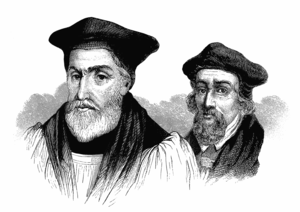
Hugh Latimer & Nicholas Ridley
Martyred in 1555
The British Candle
By Scott Hubbard
For those familiar with the English Reformation, the name Latimer sounds incomplete on its own. It demands a Ridley.

Bishops Hugh Latimer and Nicholas Ridley are fastened together in history primarily because they were fastened to the same stake on October 16, 1555, on the north side of Oxford. But Latimer and Ridley share more than a martyrdom. The bishops also join each other on the list of England’s most influential Reformers — men and women whose allegiance to Scripture and the glory of Christ transformed England from a Catholic kingdom to a lighthouse of Reformation.
Both Latimer and Ridley lived during the reigns of four English monarchs: Henry VII, Henry VIII (the one with all the wives), Edward VI, and Mary I (aka “Blood Mary”). Both witnessed the Reformation’s tug and pull under Henry VIII’s tentative acceptance, Edward VI’s warm embrace, and Mary I’s violent resistance to Reformed doctrine. But they were anything but casual observers.
Latimer the Preacher
Latimer, born around 1485, spent the first thirty years of his life a zealous Catholic — or, in his words, an “obstinate Papist.” “I was as obstinate a Papist as any was in England,” he wrote, “insomuch that when I should be made bachelor of divinity, my whole oration was against Philip Melanchthon [i.e., Luther’s right-hand man].”
But soon after Latimer’s anti-Reformation oration, a young Cambridge divine named Thomas Bilney approached him with a request. Would Latimer allow Bilney to privately explain his own Reformed faith? Latimer agreed, and from then on he “began to smell the Word of God, and forsook the school doctors and such fooleries.” Latimer gathered up the arrows he had been shooting at the Reformation, and he started pointing the bow in the other direction. Throughout the next couple decades, he distinguished himself as a fervent Reformed preacher, at times enjoying Henry VIII’s favor for it, and at other times fearing his persecution (depending on the king’s mood).
Perhaps the most fruitful years of Latimer’s ministry came under Edward VI’s short reign, from 1547 to 1553. Despite his age, Latimer assisted Archbishop of Canterbury Thomas Cranmer in reforming the English church, and he also preached like a man who just couldn’t stop. According to J.C. Ryle, “No one of the Reformers probably sowed the seeds of Protestant doctrine so widely and effectually among the middle and lower classes as Latimer.”
Then, in 1553, Queen Mary came to power, and Latimer was sent to a cell in the Tower of London.
Ridley the Scholar
Ridley, nearly twenty years Latimer’s junior, was born around 1502 near the border of Scotland. Throughout the next five decades, he would become one of England’s sharpest intellects, even going so far as to memorize all the New Testament letters — in Greek.
After attending Cambridge’s Pembroke College in his teenage years, Ridley continued his studies in France, where he likely encountered Reformation teachings. Unlike Latimer, Ridley left no clear account of his passage from Catholic priest to Protestant preacher. But we do know that he signed the 1534 decree against the pope’s supremacy, that he accepted the post of chaplain to Archbishop Cranmer three years later, and that he renounced the Catholic doctrine of transubstantiation by 1545. When he became the bishop of London in 1550, he replaced the stone altars in London’s churches with plain wooden tables. According to Ridley and the Reformers, communion was a spiritual feast, not a sacrifice.
Ridley’s scholarly abilities launched him from one prestigious post to the next, even under Henry VIII’s capricious reign. From Canterbury to Westminster to Soham to Rochester to London, Ridley studied, preached, and, once Edward VI took the throne, threw himself into Cranmer’s reforms.
But then Queen Mary came to power, and Ridley joined Latimer in the Tower.
England’s Candle
On October 16, 1555, after spending eighteen months in a tower cell, Latimer and Ridley met at an Oxford stake. With Latimer in a frock and cap, and Ridley in his bishop’s gown, the two men talked and prayed together before a smith lashed them to the wood.
Ridley was the first to strengthen his friend. “Be of good heart, brother, for God will either assuage the fury of the flame, or else strengthen us to abide it.” As the bundle of sticks caught fire beneath them, Latimer had his turn. Raising his voice so Ridley could hear, he cried, “Be of good comfort, Master Ridley, and play the man; we shall this day light such a candle, by God’s grace, in England, as I trust shall never be put out.”
Three years later, Mary I died and passed the kingdom to her half-sister Elizabeth, a Protestant queen. And Latimer and Ridley’s candle burst into a torch.
Recent Comments